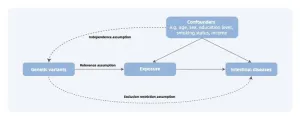(Press-News.org) Methane is the second-largest contributor to climate warming after carbon dioxide, and so scientists have put a lot of attention toward addressing one of the top sources: methane emissions from livestock. In other words, cow burps are bad for the planet.
Farmers add various seaweeds to cow diets as a source of protein, unsaturated fats, and other health-promoting ingredients that provide immediate energy, says Dipti Pitta of the University of Pennsylvania School of Veterinary Medicine, and a 2016 study in Australia found that feeding sheep a species of red seaweed called Asparagopsis taxiformis (AT) eliminated methane emissions by 80%.
But the effects of this seaweed vary widely, and so researchers from Pitta’s Agricultural Systems and Microbial Genomics Laboratory (ASMG lab) and Pennsylvania State University undertook an assessment of how it alters the microbiome in the rumen, a compartment of a cow’s stomach. The results are published in the journal mBio.
The researchers randomly split 20 cows between four treatments: a high dose of AT; a low dose of this red seaweed; oregano, which also inhibits methane formation; and the control group. They rotated the animals among the treatments in four 28-day periods. The team found that the high dose of the seaweed inhibited methane emissions by 55% in the first two periods, but the effect appears short-lived. It gradually declined by the third and fourth periods.
Pitta says this is one of the first studies examining how methane is formed in the rumen and how methane pathways are altered under various mitigation strategies, noting the importance of preserving microbiome health and animal productivity when addressing methane reduction. Past research has not looked at the effects of AT on microbial populations and their functional pathways in this level of detail.
The researchers found that in the first two 28-day periods, the high dose of seaweed led to a near total elimination of Methanosphaera, a microbe that uses hydrogen to reduce methanol to methane, in the rumen. Pitta says that this is important because the seaweed treatment didn’t have the same effect on other microbes that produce methane, leading researchers to believe that Methanosphaera plays a larger role in methane formation than previously thought.
However, the study explains that Methanosphaera populations spiked in later periods because they were unable to inactivate bromoform, a substance in seaweeds that suppresses the formation of methane in the rumen.
The study also explored the activity of enzymes involved in methanogenesis, the process of producing methane as a byproduct of energy metabolism. First author Nagaraju Indugu, a senior research investigator in the ASMG lab, says the enzymes involved in this pathway were reduced, compared to the control group, when the cows were given AT.
The authors also note that, while they expected indirect effects of AT on bacteria in the microbiota, they also found direct effects that were less expected. Specifically, types of bacteria that produce butyrate, a short-chain fatty acid serving as an energy source for cows, were significantly increased in seaweed-treated animals compared to the control group.
“It’s very important to understand what the nutrient content of seaweed is and what the antimicrobial effects of seaweeds are so that we better understand the impact of the overall inclusion of different concentrations of seaweeds to the animal diet,” Pitta says.
Indugu says the past work of the ASMG lab led to the current study. Researchers previously reported that the organic compound 3-Nitrooxypropanol reduced methane emissions by 26%, and a subsequent study determined the microbial characteristics of low-methane-emitting cows.
Looking ahead, Pitta says the lab is working on combining different strategies, such as testing seaweed in the diets of cows that have been identified as high methane emitters or low methane emitters. “Combining those with the seaweeds might give us an opportunity to effectively reduce methane by a much higher magnitude than when you do any one strategy alone,” she says.
Pitta adds that researchers are also investigating different doses of seaweed varieties in methanogenic cultures, which will provide more specificity on the concentrations necessary to inhibit methanogenesis.
Dipti Pitta is the Mark Whittier and Lila Griswold Allam Associate Professor of Ruminant Nutrition at the University of Pennsylvania School of Veterinary Medicine.
Nagaraju Indugu is a senior investigator in bioinformatics in the Agricultural Systems and Microbial Genomics Laboratory at Penn Vet.
The other co-authors are Joseph S. Bender, Grace Dai, Satvik Garapati, Meagan L. Hennessy, Kapil Narayan, Reeti Shah, and Bonnie Vecchiarelli of Penn Vet; Camila Lage, Audino Melgar, and Alexander N. Hristov, Susanna E. Räisänen, Hannah A. Stefenoni, Sergio A. Welchez, and Derek Wasson of Penn State University; and Charles Yarish of the University of Connecticut.
This research was supported by the U.S. Department of Agriculture National Institute of Food and Agriculture Federal Appropriations (PEN 04538, 1000803, and 2017-05832).
END
Understanding how a red seaweed reduces methane emissions from cows
New research from the School of Veterinary Medicine has implications for addressing a leading contributor to climate warming
2024-07-22
ELSE PRESS RELEASES FROM THIS DATE:
Genome study informs restoration of American chestnut tree
2024-07-22
Native trees adapt to the climate and environmental conditions of their area to survive. Researchers in the College of Natural Resources and Environment in collaboration with the American Chestnut Foundation confirmed this by examining the genome of American chestnut trees sampled throughout the Appalachian Mountain range and grouping the samples according to their specific environmental region.
The research, recently published in the Proceedings of the National Academy of Sciences journal, has the potential to help the ...
Improved efficacy of pembrolizumab when combined with sEphB4-HSA in HPV-negative EphrinB2-positive HNSCC
2024-07-22
“Future development for sEphB4-HSA in HNSCC is likely to focus on patients with HPV-negative disease where there is greatest need to improve on the outcomes with pembrolizumab monotherapy.”
BUFFALO, NY- July 22, 2024 – A new research paper was published in Oncotarget's Volume 15 on July 10, 2024, entitled, “Improved efficacy of pembrolizumab combined with soluble EphB4-albumin in HPV-negative EphrinB2 positive head neck squamous cell carcinoma.”
Patients with relapsed or metastatic head and neck squamous cell carcinoma (HNSCC) after primary local ...
Sleep and social media in tweens: Tips for better rest
2024-07-22
Toronto, ON - The US Surgeon General recently recommended a warning label for social media platforms due to concerns about their impact on youth mental health. The Surgeon General’s Advisory on Social Media and Youth Mental Health highlighted potential links between social media use and poor sleep quality in youth. Considering these concerns, what specific actions can adolescents and parents take to improve sleep?
A new national study, published in the Journal of Adolescent Health, offers insights into screen habits linked with better sleep.
“Ensuring adolescents get enough sleep is vital, as it supports ...
Effect of cash benefits on health care utilization and health
2024-07-22
About The Study: In this randomized study, individuals who received a cash benefit had significantly fewer emergency department visits, including those related to behavioral health and substance use, fewer admissions to the hospital from the emergency department, and increased use of outpatient subspecialty care. Study results suggest that policies that seek to alleviate poverty by providing income support may have important benefits for health and access to care.
Corresponding Author: To contact the corresponding author, Sumit D. Agarwal, M.D., M.P.H., Ph.D., email sagarwal14@bwh.harvard.edu.
To access the embargoed study: Visit our For The Media ...
Mendelian randomization analysis for intestinal disease: Achievement and future
2024-07-22
Traditional epidemiological studies have identified numerous potential risk factors, but observational studies have struggled to establish causal links due to confounding factors and reverse causation. Theoretically avoiding confounding and reverse causation, Mendelian randomization (MR) infers causality, offering novel research perspectives and methods for investigating risk factors of intestinal diseases (Figure 1).
MR research on intestinal disease
Based on MR methodology, researchers have identified lifestyle factors, circulating nutrients, and obesity as being associated with the risk of ...
Improving the design of mRNA-loaded nanocarriers for targeted therapies
2024-07-22
Among the vastly different ways of tackling a disease, controlling the genetic expression of cells is undoubtedly one of the most powerful. Over the past few decades, scientists have come up with dozens of innovative strategies that involve using messenger RNA (mRNA) to ‘force’ cells to build specific proteins. These mRNA-based therapies have recently gained prominence as vaccines against infectious diseases like COVID-19. Additionally, they hold significant potential for treating cancer and genetic disorders.
Since mRNA itself is ...
Chimpanzees gesture back and forth quickly like in human conversations
2024-07-22
When people are having a conversation, they rapidly take turns speaking and sometimes even interrupt. Now, researchers who have collected the largest ever dataset of chimpanzee “conversations” have found that they communicate back and forth using gestures following the same rapid-fire pattern. The findings are reported on July 22 in the journal Current Biology.
“While human languages are incredibly diverse, a hallmark we all share is that our conversations are structured with fast-paced turns of just 200 milliseconds on average,” ...
Deep-ocean floor produces its own oxygen
2024-07-22
An international team of researchers, including a Northwestern University chemist, has discovered that metallic minerals on the deep-ocean floor produce oxygen — 13,000 feet below the surface.
The surprising discovery challenges long-held assumptions that only photosynthetic organisms, such as plants and algae, generate Earth’s oxygen. But the new finding shows there might be another way. It appears oxygen also can be produced at the seafloor — where no light can penetrate — to support the oxygen-breathing (aerobic) sea life living in complete darkness.
The ...
Prenatal cannabis use and maternal pregnancy outcomes
2024-07-22
About The Study: The results of this cohort study suggest that prenatal cannabis use was associated with several adverse maternal health outcomes during pregnancy. Continued research is needed to understand whether characteristics of prenatal cannabis use (e.g., dose, mode, and timing) moderate these associations.
Corresponding Author: To contact the corresponding author, Kelly C. Young-Wolff, Ph.D., M.P.H., email kelly.c.young-wolff@kp.org.
To access the embargoed study: Visit our For The Media ...
Prevalence of epilepsy in people of sexual and gender minoritized groups
2024-07-22
About The Study: The findings of this study suggest that sexual and gender minority adults in the U.S. have a disproportionate prevalence of epilepsy. The reasons for this disparity are likely complex and may be associated with biological and psychosocial determinants of health unique to this population; as such, these individuals are in need of protected access to medical care.
Corresponding Author: To contact the corresponding author, Emily L. Johnson, M.D., M.P.H., email ejohns92@jhmi.edu.
To access the embargoed study: Visit our For The Media website at this link https://media.jamanetwork.com/
(doi:10.1001/jamaneurol.2024.2243)
Editor’s ...
LAST 30 PRESS RELEASES:
Kennesaw State University’s Jerry Mack named Paul “Bear” Bryant Newcomer Coach of the Year
Ancient teeth are treasure troves of data on Iron Age lifestyles
Avocados may become easier to grow in India—but not if global emissions remain high
Pregnant women with IBD show heightened inflammation in vaginal mucosa
Underwater photos show seabirds, seals and fish interacting with a tidal turbine in Washington State
1 in 5 surveyed UK adults who have experienced the death of a pet report it as more distressing than experienced human deaths, with significant rates of prolonged grief disorder symptoms also being re
Polyester microfibers in soil negatively impact the development of cherry tomato plants in experiments, raising concerns over the potential effect of high levels of such contaminants
LGBTQ+ adults may be around twice as likely to be unemployed or to report workforce non-participation compared to heterosexual adults, per large representative Australian survey
Horses can smell fear: In experiments where horses smelled sweat from scared humans, they reacted to scary and sudden events with increased fear and reduced human interaction
New synaptic formation in adolescence challenges conventional views of brain development
Scientists identify target to treat devastating brain disease
Oliver Zielinski selected as Fellow of The Oceanography Society
Has progress stalled on gender equality at work?
Quantum simulator sheds light on how nature moves energy in systems like photosynthesis and solar conversion
Can a hashtag help prevent atrocities? Study shows social media can be a powerful tool
The American Ornithological Society (AOS) announces the winner of the 2025 Wesley Lanyon Award
Woolly rhino genome recovered from Ice Age wolf stomach
An earthquake on a chip: New tech could make smartphones smaller, faster
New research shows how AI tools are expanding individual capabilities while contracting scientific attention
A nanomaterial flex — MXene electrodes help OLED display technology shine, while bending and stretching
Global research team uncovers mechanism by which metabolites guide cellular decisions
Work hours, stress, and burnout among resident physicians
Quality of life of parents of premature infants
Should younger and older people receive different treatments for the same infection?
Scientists discover how fast the world’s deltas are sinking
Scientists demonstrate first-time use of AI for genetic circuit design
Copenhagen researchers make the front page of Nature: Solving the mystery of the universe's ‘little red dots’
Seoul National University-Drexel University team achieves world's highest efficiency fully stretchable OLEDs with 17% external quantum efficiency
Hydrogel cilia set new standard in microrobotics
Application of orthogonal CNOP-I in a convection-allowing ensemble prediction system based on CMA-MESO for improving extreme precipitation skill
[Press-News.org] Understanding how a red seaweed reduces methane emissions from cowsNew research from the School of Veterinary Medicine has implications for addressing a leading contributor to climate warming





